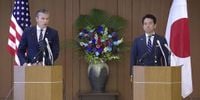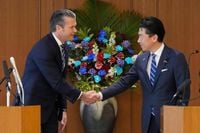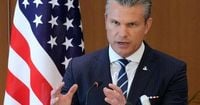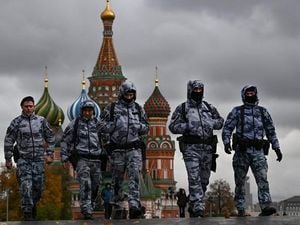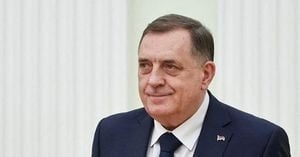In a significant move that could reshape the security landscape of East Asia, U.S. Defense Secretary Pete Hegseth on Wednesday, October 29, 2025, publicly welcomed Japan’s determination to accelerate its ongoing military buildup and boost defense spending—a shift that comes amid mounting regional tensions and growing concerns over China’s military assertiveness.
Speaking in Tokyo after meeting with his Japanese counterpart, Defense Minister Shinjiro Koizumi, Hegseth made it clear just how seriously both countries view the current security environment. “The threats we face are real, and they are urgent. China’s unprecedented military buildup and its aggressive military actions speak for themselves,” Hegseth said, according to the Associated Press. He stressed, “Make no mistake about it, our alliance is critical to deterring Chinese military aggression, to responding to regional contingencies, and keeping our countries safe.”
Hegseth’s visit followed a historic summit between Japanese Prime Minister Sanae Takaichi—who took office only a week prior—and U.S. President Donald Trump. During their first meeting, Takaichi committed to an ambitious increase in Japan’s defense spending, pledging to raise expenditures to 2% of the country’s gross national product (GNP) by March 2026. This target, originally set for a later date, will now be met two years ahead of schedule, as reported by Reading Eagle and other outlets. The move is widely seen as a direct response to the shifting security dynamics in the Indo-Pacific region.
“It’s wonderful,” Hegseth remarked when asked about Tokyo’s resolve to accelerate the timing of the planned increase and to develop additional military investment plans. “We’re going to invest now and invest quickly while we still have time,” he added, signaling urgency and a sense of shared purpose between the allies.
For decades, Japan’s post-World War II pacifist Constitution sharply limited its use of military force, restricting the Self-Defense Forces (SDF) to strictly defensive roles. But that long-standing policy began to shift with the adoption of the 2022 security strategy, which called for more offensive capabilities and eased restrictions on arms exports. The latest announcements mark a further break from the past, as Japan seeks to build a more self-sufficient military while also deepening its security partnership with the United States.
“It’s an important step forward, and one that we hope would be implemented and believe will be as soon as possible,” Hegseth told a joint news conference with Koizumi. “The result, through our shared strength, will deter threats.”
Notably, Hegseth emphasized that the U.S. government had not demanded Japan’s spending increase. “We talked about training and capabilities and spending and all the ways in which each of our countries are committing to both our individual defense and our mutual defense,” he said, according to AP. “But there were certainly no demands placed on Japan from the United States.”
This point is especially significant in light of recent reports that Trump administration officials have urged Tokyo to increase military expenditures—echoing calls for NATO allies to reach a 5% GDP defense spending target by 2035, with 3.5% for core needs and 1.5% for infrastructure and related investments. However, Hegseth was careful to clarify that Japan’s new commitments are voluntary and reflect Tokyo’s own assessment of the regional threat environment.
Japan’s defense buildup is being concentrated on its southwestern islands, a region seen as particularly vulnerable to Chinese military pressure. The government has already moved up the planned deployment of medium- and long-range missiles, including U.S.-made Tomahawk cruise missiles and domestically produced Tupe-12 anti-ship missiles. In another sign of deepening U.S.-Japan defense ties, Koizumi confirmed that the two countries have agreed to expedite deliveries of U.S.-manufactured Advanced Medium Range Air-to-Air Missiles (AMRAAM), though he declined to provide specifics.
Japan’s military modernization is not just about China. The government has also cited rising tensions with North Korea and Russia as key factors driving its security overhaul. The revised national security strategy, which will be updated several years ahead of schedule, is expected to further expand the SDF’s capabilities and roles—solidifying the nation’s shift from its postwar pacifist stance.
“The threats we face are real, and they are urgent,” Hegseth reiterated, pointing to China’s “unprecedented military buildup and its aggressive military actions.” The defense secretary’s remarks echoed growing concerns in Washington and Tokyo that the regional balance of power is shifting rapidly, with potential consequences for both countries’ security and for the broader Indo-Pacific region.
Prime Minister Takaichi’s government is also seeking to further relax restrictions on weapons transfers, building on the momentum of the 2022 reforms. These changes could enable Japan not only to better equip its own forces but also to contribute more actively to the defense of like-minded partners in the region—a prospect that has drawn both praise and criticism at home and abroad.
For supporters of the new direction, the rationale is straightforward: a stronger, more capable Japanese military is essential for deterring aggression and maintaining stability. “We’re going to invest now and invest quickly while we still have time,” Hegseth insisted, capturing the sense of urgency that pervades official thinking in both capitals.
Yet the transformation is not without controversy. Some Japanese citizens and lawmakers remain wary of abandoning the pacifist principles that have guided the country since 1945. Others argue that the security environment has changed so dramatically that Japan has little choice but to adapt. The government’s efforts to further relax arms export rules and expand the SDF’s offensive capabilities are likely to remain subjects of intense debate.
Meanwhile, regional rivals are watching closely. China has repeatedly criticized any moves by Japan to increase its military power, portraying such steps as destabilizing and provocative. North Korea, too, has denounced Japanese defense reforms, warning of an arms race in Northeast Asia. Russia, for its part, has stepped up its own military activities near Japanese territory, adding another layer of complexity to Tokyo’s strategic calculations.
Despite these challenges, Hegseth and Koizumi projected unity and determination. The joint news conference in Tokyo, complete with handshakes and expressions of mutual respect, underscored the enduring strength of the U.S.-Japan alliance—a partnership that has served as the foundation of regional security for generations.
As Japan moves to implement its new defense commitments and revise its national security strategy, the coming months will test the resolve of both governments. But for now, at least, the message from Tokyo and Washington is clear: the alliance is strong, the threats are real, and the time to act is now.
